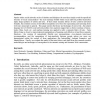Free Online Productivity Tools
i2Speak
i2Symbol
i2OCR
iTex2Img
iWeb2Print
iWeb2Shot
i2Type
iPdf2Split
iPdf2Merge
i2Bopomofo
i2Arabic
i2Style
i2Image
i2PDF
iLatex2Rtf
Sci2ools
IJSWIS
2006
2006
Unraveling the Taste Fabric of Social Networks
Popular online social networks such as Friendster and MySpace do more than simply reveal the superficial structure of social connectedness--the rich meanings bottled within social network profiles themselves imply deeper patterns of culture and taste. If these latent semantic fabrics of taste could be harvested formally, the resultant resource would afford completely novel ways for representing and reasoning about web users and people in general. This paper narrates the theory and technique of such a feat--the natural language text of 100,000 social network profiles were captured, mapped into a diverse ontology of music, books, films, foods, etc., and machine learning was applied to infer a semantic fabric of taste. Taste fabrics bring us closer to improvisational manipulations of meaning, and afford us at least three semantic functions-- the creation of semantically flexible user representations, cross-domain taste-based recommendation, and the computation of taste-similarity between...
| Added | 13 Dec 2010 |
| Updated | 13 Dec 2010 |
| Type | Journal |
| Year | 2006 |
| Where | IJSWIS |
| Authors | Hugo Liu, Pattie Maes, Glorianna Davenport |
Comments (0)

